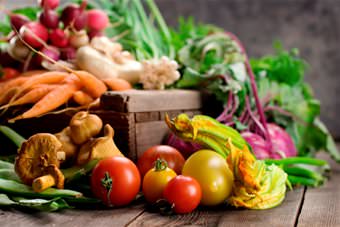How to use Ayurvedic Food choices to Stay Healthy this Winter
Date Posted:9 June 2011

Each season we pass through is linked to an Ayurvedic Mind-Body type, or “Dosha”. Spring links to Kapha, Summer with Pitta and Winter with Vata. These respective Doshas have a tendency to increase during their associated season - the heat of summer tends to push the Pitta in us, whilst a cold and windy winter tends to increase our Vata.
These seasonal movements of the Doshas in our physiologies can be offset by eating appropriately for the season. Time and place are important aspects in choosing what to eat, and most of us unconsciously work to balance these all the time. Take as a simple example the cool beverages and foods we eat in summer, which balances pitta, and the warm comfort of a bowl of hot soup on a chilly evening, balancing vata.
Vata dosha, our winter dosha, is the Air and Space elements, and looks after, or is found in all movement of our body. During winter, even for people with little Vata as their constitution, it is important to be aware of, and take action to balance vata.
Signs of an out-of-balance Vata include an non-regular digestion, constipation, intestinal discomfort & fatigue.
Choosing Foods to Balance Vata
Hot and cooked foods are the key elements in a choosing a diet to pacify Vata dosha. Warm and Nourishing soups, cooked cereals such as porridge, hearty grains, nutritious drinks and rich desserts all serve to balance Vata, and luckily tend to be perfect for the colder weather.
To Keep Vata in Balance:
- Look for sweet, salty & sour tastes
- Stay clear of pungent, astringent & bitter foods.
- All Dairy tends to pacify Vata - although to make it more digestible, always boil milk before you drink it, and a pinch of cardamom or ginger will aid this.
- Sweet lassi is a great lunchtime drink made with fresh yoghurt (if possible), water and small amount of spices such as cardamom, ginger, sugar.
- Look for sour, sweet & heavy fruits - oranges, avocados, bananas, grapes, cherries, peaches, melons, plums, berries, pineapples, mango & papaya.
- Reduce the raw salads favoured in Summer, cooked & hearty vegetables should be encouraged. Carrots, beetroot, asparagus and sweet potatoes are good options.
- In moderation, these veggies are also fine: peas, broccoli, cauliflower, courgettes, potatoes & leafy greens (chopped fine). Cook with Ghee or oil and use Vata-pacifying spices.
Vata balancing spices include cardamom, cinnamon, salt, mustard seed, ginger, and black pepper in smaller quantities. Vata churna is a pre-made spice mixture that balances vata and can be sprinkled on food or ideally used in cooking - simply saute in ghee or oil before combining with your dish.
In general, look for foods that are liquid over dry, and warm/hot rather than cold. Drink a good amount of warm water, and sip Vata Tea during the day. Almond Energy Drink is another great drink for the winter season.
Regular Meal Times!
Vata is pacified by a regular routine. Eating three good meals a day, and aim to eat them at the same times. Don’t skip mealtimes, especially the first meal of the day. Lunchtime should be the heaviest meal of the day, as this is the time our digestive fire is strongest, and best able to properly digest and gain nourishment from the meal.
Go lighter for the evening meal, favouring soups or other lighter options, and look to have this at least several hours prior to bed. We hope these tips give some inspiration and help keep you healthy and cold-free this winter!
Related articles:
- Why Almonds are an Ayurvedic Super Food (getbalance.co.nz)
- Strengthen Your Immune System the Natural Way (getbalance.co.nz)



